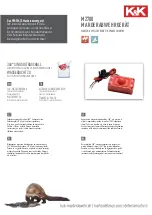
The first case corresponds also to conditions on non compensated lines and in cases, when
the capacitor is bypassed either by spark gap or by the bypass switch, as shown in phasor
diagram in figure
. The resultant reactance is in this case of inductive nature and the fault
currents lags source voltage by 90 electrical degrees.
The resultant reactance is of capacitive nature in the second case. Fault current will for this
reason lead the source voltage by 90 electrical degrees, which means that reactive current will
flow from series compensated line to the system. The system conditions are in such case
presented by equation
1
>
+
C
S
L
X
X
X
EQUATION1936 V1 EN-US
(Equation 73)
en06000608.vsd
I
F
U
S
U
’
M
=
H
U
L
H
U
S
With bypassed
capacitor
I
F
H
U
L
U
S
H
U
C
U
M
H
U
S
With inserted
capacitor
IEC06000608 V1 EN-US
Figure 97: Phasor diagrams of currents and voltages for the bypassed and inserted
series capacitor during current inversion
It is a common practice to call this phenomenon current inversion. Its consequences on
operation of different protections in series compensated networks depend on their operating
principle. The most known effect has current inversion on operation of distance IEDs (as
shown in section
for more details), which cannot be used for the
protection of series compensated lines with possible current inversion. Equation
also big dependence of possible current inversion on series compensated lines on location of
series capacitors. X
L1
= 0 for faults just behind the capacitor when located at line IED and only
the source impedance prevents current inversion. Current inversion has been considered for
many years only a theoretical possibility due to relatively low values of source impedances (big
power plants) compared to the capacitor reactance. The possibility for current inversion in
modern networks is increasing and must be studied carefully during system preparatory
studies.
The current inversion phenomenon should not be studied only for the purposes of protection
devices measuring phase currents. Directional comparison protections, based on residual
(zero sequence) and negative sequence currents should be considered in studies as well.
Current inversion in zero sequence systems with low zero sequence source impedance (a
number of power transformers connected in parallel) must be considered as practical
possibility in many modern networks.
Low frequency transients
SEMOD168320-220 v2
Series capacitors introduce in power systems oscillations in currents and voltages, which are
not common in non-compensated systems. These oscillations have frequencies lower than the
rated system frequency and may cause delayed increase of fault currents, delayed operation of
spark gaps as well as, delayed operation of protective IEDs. The most obvious difference is
generally seen in fault currents. Figure
presents a simplified picture of a series
compensated network with basic line parameters during fault conditions. We study the basic
Section 7
1MRK 505 343-UEN B
Impedance protection
166
Application manual
Содержание Relion 670 series
Страница 1: ...RELION 670 SERIES Line differential protection RED670 Version 2 1 IEC Application manual...
Страница 2: ......
Страница 40: ...34...
Страница 64: ...58...
Страница 150: ...144...
Страница 406: ...400...
Страница 472: ...466...
Страница 494: ...488...
Страница 512: ...506...
Страница 524: ...518...
Страница 604: ...598...
Страница 686: ...680...
Страница 718: ...712...
Страница 722: ...716...
Страница 758: ...752...
Страница 759: ...753...
















































